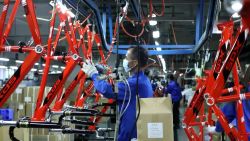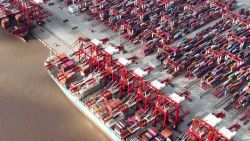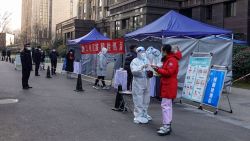China’s factories are picking up new orders and hiring workers again, defying the recent slowdown in the world’s second-biggest economy.
The country’s huge manufacturing industry unexpectedly rebounded in March, government figures showed Sunday. The official purchasing managers index for the month jumped to 50.5, compared to 49.2 in February. A reading above 50 indicates growth from the previous month.
A separate survey of manufacturing activity by media group Caixin and research firm Markit released Monday was also unexpectedly positive.
Goods made in Chinese factories are shipped all over the world, and their demand is often viewed as a barometer for the health of the global economy.
Growth in China’s factory sector shifted into reverse at the end of last year and economists polled by Refinitiv had predicted this trend would continue.

The figures “will go a long way to allaying slowdown fears about China, at least in the short-term,” wrote Jeffrey Halley, senior Asia-Pacific market analyst at investment firm Oanda, in a market commentary Monday.
Investors will now be focusing on the next stage of trade negotiations between the United States and China, which are due to take place in Washington this week, Halley added.
The rebound in China’s manufacturing sector and optimism over trade talksbetween the world’s top two economies boosted Asian stock markets Monday.
China’s Shanghai Composite index ended the day up 2.6%. Hong Kong’s Hang Seng (HSI) gained 1.7% and Japan’s Nikkei (N225) rose 1.4%.
Stimulus is starting to bear fruit
Chinese growth has lost momentum following government efforts to crack down on risky lending, which starved many companies of the funds they needed to expand.
The world’s second largest economy has also started feeling the effects of the trade war with the United States, which has resulted in new tariffs on about $250 billion of Chinese exports.
The Chinese government last month predicted economic growth of between 6% and 6.5% in 2019. That’s below last year’s 6.6% rate of expansion, which was already China’s slowest annual growth in three decades.
Beijing in response has resorted to trillions of dollars worth of new measures intended to stimulate the economy, including tax cuts for businesses, infrastructure spending and looser monetary policy.
March’s upbeat data shows these policies “are apparently bearing fruit,” wrote Raymond Yeung, a senior economist at investment bank ANZ, in a note to clients Monday.
The Caixin PMI release noted that factories were hiring more workers for the first time in five years.
Some analysts said the latest economic figures indicated that China’s economy had now bottomed out, and growth would likely continue to strengthen in the coming months as the effects of stimulus measures are felt.
But others warned that it was still too early to tell if China’s economic picture was improving. “We still think growth could weaken again in the near-term,” said Julian Evans-Pritchard, senior China economist at research firm Capital Economics.

























